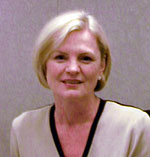By Tim Pugmire
Minnesota Public Radio
June 3, 2002
School districts officials throughout Minnesota have been laying off teachers, raising fees and slashing services to balance their budgets for the coming school year. Administrators blame the drastic cuts on rising costs and insufficient state funding. But state spending on public education has been steadily increasing, not decreasing. And that has some policymakers questioning whether schools will ever have enough money.
| |
|
|
|
||
Cost cutting at Richfield High School means more students are walking home after classes, or waiting for rides. School district officials recently eliminated the long-available option of free bus rides for secondary students living within two miles of school. Those students must now pay $170 a year to ride the school bus. Sophomore Pedro Delacruz is one of the students who's no longer riding.
"We think it's bad because a lot of people have to find another way to get here," Delacruz said. "A lot of people have to walk, and it's like bad for all the students."
After local residents defeated a request for additional tax support last fall, Richfield school officials had to find ways to fill a projected $2.5 million hole in next year's budget. The district spent $1.3 million last year, or about four percent of its operating budget, to run buses. Transportation is a budget category not directly connected to the classroom, which makes it vulnerable. But Superintendent Barbara Devlin says none of the cuts were easy.
"We have heard from some people that, you know that is an inconvenience," Devlin said. "However, we did have also many parents saying we'd rather have you cut things like that than cut classroom programs."
School districts throughout the state have been making similar reductions. Combined cuts among Twin Cities metro area districts are expected to top $100 million. Scott Croonquist, executive director of the Association of Metropolitan School Districts, blames the bleak financial picture on less than expected K-12 funding last year from state Legislature. That modest, inflationary increase came two years after lawmakers pumped a whopping $1.3 billion of new money into public schools.
"You can't provide a decent increase one year and then think that schools are going be able to live off that for four years," Croonquist said. "The fact of the matter is that costs go up every year, and that unless the Legislature maintains the type of committment that they showed in 1999, the result will in fact be a reduced services, or cuts to education."
Croonquist's view is echoed by urban and rural educators alike, as they try to explain the current school budget mess. But not everyone is buying the explanation. Governor Ventura, for one, says he's "sick and tired" of hearing school officials talk about cuts.
"They weren't cut," Ventura said. "They got more money than they got the year before. That's not a cut. They just didn't get everything they asked for."
Ventura championed the 1999 boost in school spending, but now he's quick to criticize the ever expanding state cost for education. The Minnesota Department of Children, Families and Learning says school district revenues for this year, including all federal, state and local funding, total $7.9 billion. That's about $9,200 for each of Minnesota's 854 thousand students. Over the last 10 years, the total revenue has grown by nearly 72 percent, while enrollment increased just 11 percent.
Ventura questions districts' ability to live within their means: "To do the same job you just did a year earlier, nothing more, the same job, you got more money beyond inflation, well beyond inflation, why would it require any cuts? Where is the money going?"
| |
|
|
|
||
School leaders say costs are increasing much faster than inflation. State records show school districts spent $6.3 billion last year on operating expenses. Another $1.9 billion went toward buildings and other capital costs. Gas prices and driver salaries pushed up transportation expenditures statewide by five and a half percent last year. The cost of heat, electricty and other building operations rose 13 percent. Lunch room costs grew by six percent. And the price of teaching disabled students jumped seven and a half percent from the previous year.
Large and small school districts are also losing state money because enrollments are dropping. Vernae Hasbargen of the Minnesota Rural Education Association says fewer students don't lower expenses.
"You might lose a child, or two or three out of your third-grade section, but it's not enough to really cut your costs and reduce a teacher," Hasbargen said. "And so what you've had is this gradual erosion of your revenue generating ability because you're gradually losing kids."
State and federal mandates drive much of the cost of public education, but each school district still controls its biggest expense. Roughly 80 percent of operational costs are employee salaries and benefits. There are administrators, bus drivers, coordinators, instructional aides, nurses, psychologists and various support staff. But most are licensed teachers. Officials with the teachers' union, Education Minnesota and the Minnesota School Boards Association, say teacher salaries are increasing an average 2.8 percent this year, and 2.5 percent next year. Add in the benefits, and you've got average increases of 9.6 percent over the two years. That's marginally higher than the last few bargaining rounds.
Morgan Brown of the watchdog Minnesota Education League says many school districts, even those with big budget shortfalls, continue to spend more than they have on salaries.
"They're still signing teacher contracts they can't afford and that's leading to making additional cuts and in some cases teacher layoffs," Brown said. "And I think to a lot of parents it doesn't make sense to sign a large teacher contract and then pay for it by laying off teachers."
| |
|
|
|
||
Brown says teachers should share the responsibility of budget cuts with smaller settlements. But a report two years ago from the Office of the Legislative Auditor showed increased wages for teachers have not been a major factor in the growth of school spending. It says while some individual teachers got raises above inflation during the 1990s, the statewide average actually lagged inflation, due to retirements and the hiring of young, less expensive replacements.
The National Education Association ranks Minnesota 17th in average teacher salaries at just over $42,000, $1,100 below the national average. Education Minnesota President Judy Schaubach says the salaries aren't enough to attract and retain quality teachers.
"The uncertainty that's out there, the challenge of difficult kids, and growing class size, and lack of supplies and support just makes the kind of environment where it will be more and more challenging to get people to stay in the profession," Schaubach said.
The latest Census Bureau survey of local government finances ranks Minnesota at 18th in nation for total per-pupil spending. Economic pressures and state budget shortages will likely prevent Minnesota from gaining much ground on that list in the next few years. Meanwhile, many cash-strapped school districts are already planning to ask local voters for help again this fall.



